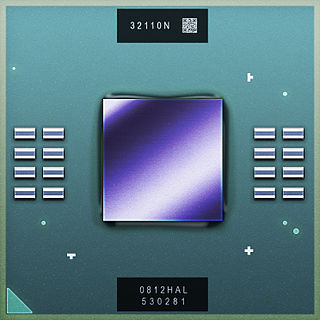
A graphics card is a computer expansion card that generates a feed of graphics output to a display device such as a monitor. Graphics cards are sometimes called discrete or dedicated graphics cards to emphasize their distinction to an integrated graphics processor on the motherboard or the central processing unit (CPU). A graphics processing unit (GPU) that performs the necessary computations is the main component in a graphics card, but the acronym "GPU" is sometimes also used to erroneously refer to the graphics card as a whole.

The GeForce 6 series is the sixth generation of Nvidia's GeForce line of graphics processing units. Launched on April 14, 2004, the GeForce 6 family introduced PureVideo post-processing for video, SLI technology, and Shader Model 3.0 support.
Cell is a 64-bit multi-core microprocessor microarchitecture that combines a general-purpose PowerPC core of modest performance with streamlined coprocessing elements which greatly accelerate multimedia and vector processing applications, as well as many other forms of dedicated computation.

Altix is a line of server computers and supercomputers produced by Silicon Graphics, based on Intel processors. It succeeded the MIPS/IRIX-based Origin 3000 servers.
HPE Integrity Servers is a series of server computers produced by Hewlett Packard Enterprise since 2003, based on the Itanium processor. The Integrity brand name was inherited by HP from Tandem Computers via Compaq.

The GeForce 7 series is the seventh generation of Nvidia's GeForce line of graphics processing units. This was the last series available on AGP cards.

The RSX 'Reality Synthesizer' is a proprietary graphics processing unit (GPU) codeveloped by Nvidia and Sony for the PlayStation 3 game console. It is based on the Nvidia 7800GTX graphics processor and, according to Nvidia, is a G70/G71 hybrid architecture with some modifications. The RSX has separate vertex and pixel shader pipelines. The GPU makes use of 256 MB GDDR3 RAM clocked at 650 MHz with an effective transmission rate of 1.3 GHz and up to 224 MB of the 3.2 GHz XDR main memory via the CPU . Although it carries the majority of the graphics processing, the Cell Broadband Engine, the console's CPU, is also used complementarily for some graphics-related computational loads of the console.

The IBM BladeCenter was IBM's blade server architecture, until it was replaced by Flex System in 2012. The x86 division was later sold to Lenovo in 2014.
The nForce 600 chipset was released in the first half of November 2006, coinciding with the GeForce 8 series launch on November 8, 2006. The nForce 600 supports Intel's LGA 775 socket and AMD's Quad FX platform and replaces the nForce 500 series.
The AMD 690 chipset series is an integrated graphics chipset family which was developed and manufactured by AMD subsidiary ATI for both AMD and Intel platforms focusing on both desktop and mobile computing markets. The corresponding chipset for the Intel platform has a marketing name of Radeon Xpress 1200 series.
The GeForce 9 series is the ninth generation of Nvidia's GeForce line of graphics processing units, the first of which was released on February 21, 2008. The products are based on an updated Tesla microarchitecture, adding PCI Express 2.0 support, improved color and z-compression, and built on a 65 nm process, later using 55 nm process to reduce power consumption and die size.
The IntelliStation is a family of workstations developed by IBM and first released in March 1997 as the follow-on to the PC Series 360 and 365. Certain IntelliStation M Pro Series were near hardware identical to low end IBM Netfinity 1000 Series network servers. In February 2002, POWER processor-based workstations, previously sold directly under the eServer pSeries brand, were also placed under the IntelliStation umbrella.

The PlayStation 3 technical specifications describe the various components of the PlayStation 3 (PS3) video game console.

SpursEngine is a microprocessor from Toshiba built as a media oriented coprocessor, designed for 3D- and video processing in consumer electronics such as set-top boxes and computers. The SpursEngine processor is also known as the Quad Core HD processor. Announced 20 September 2007.

The HP Pavilion dv9000 was a model series of laptops manufactured by Hewlett-Packard Company that featured 16:10 17.0" diagonal displays.

Fixstars Solutions, Inc. is a software and services company specializing in multi-core processors, particularly in Nvidia's GPU and CUDA environment, IBM Power7, and Cell. They also specialize in solid-state drives and currently manufacture the world's largest SATA drives.
The Namco System 357 is an arcade system board based on the Sony PlayStation 3. It was released in 2007 as the board for Tekken 6. Unlike its predecessor, it did not see widespread adoption by other manufacturers.

ThinkStation is a brand of professional workstations from Lenovo announced in November 2007 and then released in January 2008. They are designed to be used for high-end computing and computer-aided design (CAD) tasks and primarily compete with other enterprise workstation lines, such as Dell's Precision, HP's Z line, Acer's Veriton K series, and Apple's Mac Pro line.

Monokub is a computer motherboard based on the Russian Elbrus 2000 computer architecture, which form the basis for the Monoblock PC office workstation.











